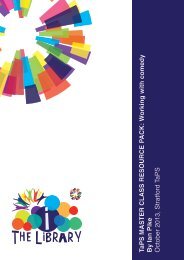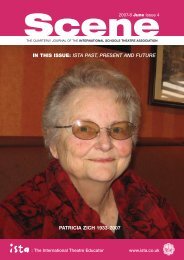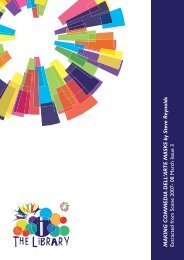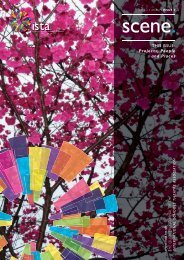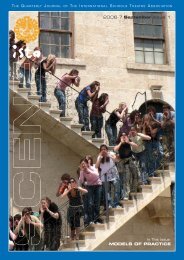ISTA/Scene March 07
ISTA/Scene March 07
ISTA/Scene March 07
Create successful ePaper yourself
Turn your PDF publications into a flip-book with our unique Google optimized e-Paper software.
Calderdale HS<br />
Beijing MS<br />
visual arts classes created art pieces<br />
that were projected in each scene that<br />
were inspired from artists of the time<br />
periods, the choir and strings classes<br />
explored music from the various time<br />
periods and the performance class<br />
explored acting styles. It included over<br />
80 students and the school supported<br />
the project by providing three in house<br />
rehearsal days when the ‘full cast’<br />
could come together to put the project<br />
onstage. There were, of course,<br />
elements that needed to be ironed out<br />
as all the pieces of the puzzle came<br />
together, but, working in this way<br />
provided an incredible depth of learning<br />
for the students and teachers alike.<br />
Rob Warren & Sherry Weeks –<br />
Atlanta International School, USA<br />
24-HOUR PLAYS<br />
Over a 24-hour period of time, working<br />
with 6 Guest Directors and 5 Guest<br />
Designers with various theatrical<br />
backgrounds (clowning, improvisation,<br />
comedy, dance, puppetry, tragedy, set<br />
design, costume design, light design,<br />
publicity & prop design.) High School<br />
students had been divided into either<br />
performance or production groups on<br />
a sign up first come first sever basis.<br />
Beginning at 7:00pm Friday night with<br />
a family dinner each performance<br />
group was given a Shakespearian<br />
sonnet to create into a 5-10 minute<br />
production using the Guest Director’s<br />
background in theatre. At the same<br />
time each production group worked on<br />
designing, building or creating their<br />
relevant production area. During the<br />
first 12 hours scripts were written,<br />
rehearsed and staged. The set,<br />
costumes, props, lights and posters<br />
had been designed and construction<br />
was taking place. At 7:00am<br />
Saturday morning both performance<br />
and production groups were putting<br />
final touches to their areas ready to<br />
perform a dress rehearsal after<br />
lunch at 12:00pm. From 1:00pm<br />
onwards students were brought<br />
into the theatre to begin staging<br />
the opening and closing of the<br />
show in addition to running a<br />
tech/dress rehearsal. Little time was<br />
left for final changes however some<br />
groups managed to fit time in. All<br />
production work had stopped and<br />
these students began working on<br />
technical positions needed to run the<br />
show, for example backstage crew,<br />
light & sound operators, ushers, tickets<br />
& concessions. At 6:00pm the<br />
audience arrived at the theatre to take<br />
their seats for a night of Theatre. What<br />
they didn’t expect was what 24 Hours<br />
of little sleep, constant pressure to<br />
taking risks and a Shakespearian<br />
Sonnet could create. At 7:00pm the<br />
curtain rose on 50 eager performers<br />
and 30-inspired production crew who<br />
had created something out of nothing<br />
in 24 hours. This project is truly a<br />
remarkable experience that shows the<br />
power of ensemble and student’s<br />
imaginations. My only criticism of this<br />
project is the final productions can<br />
focus too heavily on “in-house jokes”<br />
or “things that only the 24-Hour<br />
participants know about” and therefore<br />
the final product can often be not as<br />
clean or un-finished. However, to see a<br />
production where no one gets cut,<br />
every student is welcome and the<br />
amount of creativity that occurs over<br />
24 Hours is well worth trying.<br />
THE DEAD MAN WALKING Project<br />
by Tim Robbins<br />
The DEAD MAN WALKING School<br />
Theatre Project (the Play Project, for<br />
short) is an opportunity to broaden<br />
discussion about the death penalty<br />
and involve schools and their local<br />
communities in an inter-disciplinary<br />
dialogue about this major social issue.<br />
What is the Play Project Check it out<br />
at http://www.deadmanwalkingplay.org<br />
Any description we give you would not<br />
do justice to the experience our<br />
students had on this project. It was<br />
truly a remarkable experience all around.<br />
JUNGLE BOOK by Edward Mast<br />
This was a production I did with our<br />
Middle School students a few years<br />
ago. Although the script describes the<br />
production as being set “not in a<br />
jungle, but a jungle-gym”, we decided<br />
to take this opportunity and research<br />
how Rudyard Kipling’s writing was<br />
influenced by the time he spent living<br />
in India. Allowing the students to<br />
research Hindu myths and making<br />
connections between their Jungle<br />
Book characters and the Hindu God’s<br />
& Deities we decide to develop our<br />
production on Indian culture and<br />
traditions. Using this to guide us our<br />
design team who were made up of<br />
IBDP Visual Art and Theatre Art<br />
students, who had been influenced by<br />
a Julie Taymor production we had seen<br />
in New York, decided to design the<br />
production using masks and puppets.<br />
What later became the set and the<br />
actors’ costumes began as mock<br />
sketches of an Indian jungle, a study of<br />
animals at the Atlanta zoo, and<br />
research done on Hindu art and<br />
artefacts. This final production was a<br />
huge success both visually and<br />
through the process we took. Giant<br />
animal puppets roamed the stage,<br />
characters with masks hanging over<br />
them, traditional Indian dancing and<br />
music, and finally a group of Upper<br />
and Middle School students who had<br />
learned the true nature of theatre as an<br />
ensemble art form.<br />
Tom Wilkinson – Dresden<br />
International School, Germany<br />
(formerly at Colegio Roosevelt,<br />
Lima, Peru)<br />
From Lima<br />
We began the year wondering how to<br />
have as many students on stage as<br />
possible and not do a musical. Having<br />
always had a burning desire to visit<br />
Friedrich Durrenmatt’s THE VISIT and<br />
trusting other choices would not<br />
provide the stage time necessary for<br />
forty to fifty budding actors, Todd<br />
Welbes, who taught and directed with<br />
me, and I decided the time was right.<br />
His comment, “It’s so dark and<br />
devilish,” pushed the decision even<br />
further. We cast the show with a<br />
marvelous pair of actor lovers, Claire<br />
Zachanassian and Anton Ill, but<br />
surrounded them with a cast of<br />
villagers who managed to control the<br />
audience through almost three hours<br />
of performance. We even added song<br />
and dance as we wrote in parts for a<br />
pair of Harlequin narrators who led the<br />
<strong>Scene</strong> | 2006-7 <strong>March</strong> Issue 3 | 27



